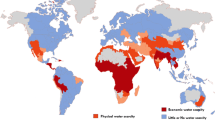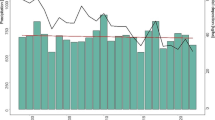Abstract
Water saving management contract (WSMC) is an innovative water saving strategy based on market mechanism. As the minimum annual project water-saving revenue agreed with water saving service company (WSSC) and water user, water-saving revenue guarantee (WRG) is one of the key elements in WSMC projects. This paper attempted to establish a model to determine the optimal WRG based on simulation method. First, a nonlinear relationship between water-saving amount and initial investment was built by industry standards. Then, the quantitative influence of water-saving awareness on water-saving amount was built based on Markov chain. Next, a random process with decreasing variance over time was used to describe the fluctuation. Next, the failure maintenance cost in water-saving system was described by renewal function. After that, an unconstraint WRG optimization model of the WSMC was constructed with the WSSC total profit difference net present value (NPV) as the objective function and a solution algorithm was designed. Then, the sensitivity analysis was performed on fluctuation coefficient, estimated model parameters and project original variables. Next, the validities analysis on water-saving revenue and water-saving cost was provided. Finally, a WSMC project case in China was studied and the solutions were compared with traditional model. The results showed that the optimized WRG in this paper was 17% higher than the original one, and the WSSC total profit difference NPV was reduced by about 1200000 yuan. Reducing appropriate initial investment and increasing assistance to water user, like enhancing its water-saving awareness, are efficient methods to improve WRG for WSSC.



Similar content being viewed by others
Availability of Data and Material
The data sets supporting the results of this article are included within the article.
References
Ahmed W, Alazazmeh A, Asif M (2022) Energy and water saving potential in commercial buildings: A retrofit case study. Sustainability 15:518. https://doi.org/10.3390/su15010518
An X, Wang X, Hu H et al (2021) Optimal allocation of regional water resources under water saving management contract. J Inf Data Manag 3:281–296. https://doi.org/10.1007/s42488-021-00059-x
Betz T, El-Rayes K, Grussing M et al (2023) Parametric estimation of equipment failure risk with machine learning and constrained optimization. J Perform Constr Facil 37:04022073. https://doi.org/10.1061/JPCFEV.CFENG-4284
Bühler F, Guminski A, Gruber A et al (2018) Evaluation of energy saving potentials, costs and uncertainties in the chemical industry in Germany. Appl Energy 228:2037–2049. https://doi.org/10.1016/j.apenergy.2018.07.045
Carbonara N, Pellegrino R (2018) Public-private partnerships for energy efficiency projects: A win-win model to choose the energy performance contracting structure. J Clean Prod 170:1064–1075. https://doi.org/10.1016/j.jclepro.2017.09.151
Carbonara N, Costantino N, Pellegrino R (2014) Revenue guarantee in public-private partnerships: A fair risk allocation model. Constr Manag Econ 32:403–415. https://doi.org/10.1080/01446193.2014.906638
Carpino C, Bruno R, Carpino V et al (2022) Improve decision-making process and reduce risks in the energy retrofit of existing buildings through uncertainty and sensitivity analysis. Energy Sustain Dev 68:289–307. https://doi.org/10.1016/j.esd.2022.04.007
Deng Q, Zhang L, Cui Q et al (2014) A simulation-based decision model for designing contract period in building energy performance contracting. Build Environ 71:71–80. https://doi.org/10.1016/j.buildenv.2013.09.010
Deng Q, Jiang X, Cui Q et al (2015a) Strategic design of cost savings guarantee in energy performance contracting under uncertainty. Appl Energy 139:68–80. https://doi.org/10.1016/j.apenergy.2014.11.027
Deng Q, Jiang X, Zhang L et al (2015b) Making optimal investment decisions for energy service companies under uncertainty: A case study. Energy 88:234–243. https://doi.org/10.1016/j.energy.2015.05.004
Gebremicael TG, Deitch MJ, Gancel HN et al (2022) Satellite-based rainfall estimates evaluation using a parsimonious hydrological model in the complex climate and topography of the Nile River Catchments. Atmos Res 266:105939. https://doi.org/10.1016/j.atmosres.2021.105939
Ghasemi M, Nejad MG, Alsaadi N et al (2022) Performance measurement and lead-time reduction in EPC project-based organizations: A mathematical modeling approach. Math Probl Eng 2022:1–15. https://doi.org/10.1155/2022/5767356
Guo K, Zhang L (2020) Guarantee optimization in energy performance contracting with real option analysis. J Clean Prod 258:120908. https://doi.org/10.1016/j.jclepro.2020.120908
Heng D (2012) Nonparametric estimation of the renewal function (In Chinese). Nanjing Normal University, Master degree
Jacobs H, Plessis J, Nel N et al (2020a) Baseline adjustment methodology in a shared water savings contract under serious drought conditions. Water SA 46:22–29. https://doi.org/10.17159/wsa/2020.v46.i1.7874
Jacobs H, Plessis J, Nel N et al (2020b) Baseline adjustment methodology in a shared water savings contract during severe water restrictions – a case study in the Western Cape, South Africa. Water SA 46:30–37. https://doi.org/10.17159/wsa/2020.v46.i1.7878
Jiang R (2010) A simple approximation for the renewal function with an increasing failure rate. Reliab Eng Syst Saf 95:963–969. https://doi.org/10.1016/j.ress.2010.04.007
Jin H, Liu S, Sun J et al (2021) Determining concession periods and minimum revenue guarantees in public-private-partnership agreements. Eur J Oper Res 291:512–524. https://doi.org/10.1016/j.ejor.2019.12.013
Karamov D, Minarchenko I, Kolosnitsyn A et al (2021) Installed capacity optimization of autonomous photovoltaic systems under energy service contracting. Energy Convers Manag 240:114256. https://doi.org/10.1016/j.enconman.2021.114256
Kumar L, Kumari R, Kumar A et al (2023) Water quality assessment and monitoring in Pakistan: A comprehensive review. Sustainability 15:6246. https://doi.org/10.3390/su15076246
Kumar L, Deitch MJ, Tunio IA et al (2022) Assessment of physicochemical parameters in groundwater quality of desert area (Tharparkar) of Pakistan. Case Stud Chem Environ Eng 6:100232. https://doi.org/10.1016/j.cscee.2022.100232
Kumbaroğlu G, Madlener R (2012) Evaluation of economically optimal retrofit investment options for energy savings in buildings. Energy Build 49:327–334. https://doi.org/10.1016/j.enbuild.2012.02.022
Lee S, Tae S, Shin S (2015) Profit distribution in guaranteed savings contracts: Determination based on the collar option model. Sustainability 7:16273–16289. https://doi.org/10.3390/su71215816
Liu B (2021) Uncertainty theory, 5th ed. Uncertainty Theory Laboratory, Beijing
Liu X, Wang X, Guo H et al (2021) Benefit allocation in shared Water-Saving Management Contract projects based on modified expected Shapley value. Water Resour Manage 35:39–62. https://doi.org/10.1007/s11269-020-02705-2
Loncar D, Milovanovic I, Rakic B et al (2017) Compound real options valuation of renewable energy projects: The case of a wind farm in Serbia. Renew Sustain Energy Rev 75:354–367. https://doi.org/10.1016/j.rser.2016.11.001
Lu Z, Shao S (2016) Impacts of government subsidies on pricing and performance level choice in Energy Performance Contracting: A two-step optimal decision model. Appl Energy 184:1176–1183. https://doi.org/10.1016/j.apenergy.2016.05.106
Ma W, Li X, Wang X (2021) Water Saving Management Contract, identification and ranking of risks based on life cycle and best-worst method. J Clean Prod 306:127153. https://doi.org/10.1016/j.jclepro.2021.127153
Ng T, Xie J, Cheung Y et al (2007) A simulation model for optimizing the concession period of public–private partnerships schemes. Int J Project Manage 25:791–798. https://doi.org/10.1016/j.ijproman.2007.05.004
Principi P, Roberto F, Carbonari A et al (2016) Evaluation of energy conservation opportunities through Energy Performance Contracting: A case study in Italy. Energy Build 128:886–899. https://doi.org/10.1016/j.enbuild.2016.06.068
Qian D, Guo J (2014) Research on the energy-saving and revenue sharing strategy of ESCOs under the uncertainty of the value of Energy Performance Contracting Projects. Energy Policy 73:710–721. https://doi.org/10.1016/j.enpol.2014.05.013
Qin X, Shao L, Jiang Z (2020) Contract design for equipment after-sales service with business interruption insurance. Eur J Oper Res 284:176–187. https://doi.org/10.1016/j.ejor.2019.12.027
Ross SM (2014) Introduction to probability models, 11th ed. Academic press
Tagar U, Volpe M, Messineo A et al (2023) Highly ordered CaO from cuttlefish bone calcination for the efficient adsorption of methylene blue from water. Front Chem 11:1132464. https://doi.org/10.3389/fchem.2023.1132464
Tan B (2020) Design of balanced energy savings performance contracts. Int J Prod Res 58:1401–1424. https://doi.org/10.1080/00207543.2019.1641240
Wang Y, Cui P, Liu J (2018) Analysis of the risk-sharing ratio in PPP projects based on government minimum revenue guarantees. Int J Project Manage 36:899–909. https://doi.org/10.1016/j.ijproman.2018.01.007
Wang Y, Gao H, Liu J (2019) Incentive game of investor speculation in PPP highway projects based on the government minimum revenue guarantee. Transp Res Part A Policy Pract 125:20–34. https://doi.org/10.1016/j.tra.2019.05.006
Wang H, Bracciano D, Asefa T (2020) Evaluation of water saving potential for short-term water demand management. Water Resour Manage 34:3317–3330. https://doi.org/10.1007/s11269-020-02615-3
Wang W, Ren L, Deng C et al (2022a) The Water-Saving Management Contract in China: Current Status, Existing Problems, and Countermeasure Suggestions. Water (basel) 14:3116. https://doi.org/10.3390/w14193116
Wang X, Li W, Guo H et al (2022b) A risk assessment model of WSMC projects under emergencies. Water Supply 22:1503–1520. https://doi.org/10.2166/ws.2021.339
Zheng T (2016) Water saving management contract in China (In Chinese). China Water Resources and Hydropower Press, Beijing
Zhong F, Li L, Guo A et al (2019) Quantifying the influence path of water conservation awareness on water-saving irrigation behavior based on the theory of planned behavior and structural equation modeling: A case study from Northwest China. Sustainability 11:4967. https://doi.org/10.3390/su11184967F
Funding
This work was supported by National Natural Science Foundation of China (No.61873084).
Author information
Authors and Affiliations
Contributions
Xiaosheng Wang provided the idea of the optimization model. Ran Li collected the data. Wei Li analyzed the data and was a major contributor in writing the manuscript. All authors read and approved the final manuscript.
Corresponding author
Ethics declarations
Ethical Approval
Not applicable.
Consent to Participate
Not applicable.
Consent to Publish
Not applicable.
Competing Interests
The authors have no relevant financial or non-financial interests to disclose.
Additional information
Publisher's Note
Springer Nature remains neutral with regard to jurisdictional claims in published maps and institutional affiliations.
Appendices
Appendix A
When the annual realized water saving income exceeds the guaranteed value, the excess is shared between WSSC and the water user; When the annual realized water savings revenue does not reach the guaranteed value, WSSC is required to compensate for the shortfall. The profit difference of each participant can be calculated from the profit difference of the project.
When the realized water saving revenue exceeds the guaranteed value of water saving revenue, we have
Water user Profit difference
When the realized water-saving revenue is less than the water-saving revenue guarantee,
Appendix B
Appendix C
Rights and permissions
Springer Nature or its licensor (e.g. a society or other partner) holds exclusive rights to this article under a publishing agreement with the author(s) or other rightsholder(s); author self-archiving of the accepted manuscript version of this article is solely governed by the terms of such publishing agreement and applicable law.
About this article
Cite this article
Li, W., Wang, X. & Li, R. Water-Saving Revenue Guarantee Optimization in Water Saving Management Contract Based on Simulation Method. Water Resour Manage 37, 5127–5146 (2023). https://doi.org/10.1007/s11269-023-03598-7
Received:
Accepted:
Published:
Issue Date:
DOI: https://doi.org/10.1007/s11269-023-03598-7







